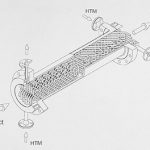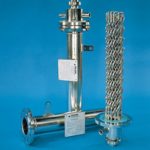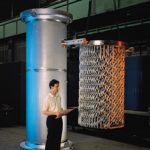The SMR mixer reactor is also used as a static mixer heat exchanger which is especially suited for viscous fluids. The SMR has very specific uses in a broad variety of applications.
Dipl.-Ing. ETH Stefano Guariento
The working principle of static mixer heat exchangers has already been explained in cpp 11/89. Three types of static mixer heat exchanger were described in that article: the monotube design, the shell-and-tube design and the SMR mixer-reactor heat exchanger. At the time, nine years ago, the SMR was still a new piece of equipment with very promising features, but with only a few known applications and a limited number of references. This article summarizes the developments during the period since then. A rich variety of applica-tions has been found for the SMR, which provides an elegant solution to a number of difficult problems.
Working principle
The flow of a viscous fluid in an empty tube is laminar, the velocity profile across the tube section is parabolic, the residence time distribution is wide and in the event of heat transfer a radial temperature profile is produced. The result of all these effects is a poor heat transfer behavior. Installing static mixing elements inside the tube achieves a radial mixing effect. The boundary layer close to the wall is renewed continuously and the heat transfer effect increased many times over.
The SMR has the same geometry as the SMX static mixer. In the SMR the bars of the SMX mixing elements are replaced by tubes, through which the heat transfer medium flows. The tubes therefore firstly represent an efficient mixing structure and secondly generate a remarkable heat transfer area ranging from 30 to 150 m2/m3. Radial mixing without separating the flow in distinct streams allows extremely homogeneous heat transfer and avoids channeling or maldistribution phenomena (clogging of tubes), such as might be caused by viscosity changes.
The geometric design of this patented mixer heat exchanger permits easy scale-up. The diameter of the SMRs that have already been installed ranges from DN 80 to DN 1500, though any diameter should be feasible in practice.
Mass polymerization
The search for a reactor that is able to re-move a large amount of heat efficiently and at the same time continuously mix the reacting material, in order to avoid temperature or concentration gradients which might have a negative effect on the reaction, led to the development of the SMR. The SMR was originally conceived as a plug flow reactor for polymerizing styrene during the production of general-purpose and impact-resistant polystyrene. More than 10 polystyrene plants around the world have adopted this equipment and it can meanwhile be considered the state of the art in plug flow polymerization reactors. The main advantages over the conventional, rotating plug flow reactors used in industry are the absence of moving parts, the gentle handling of the product (low shear rate) and the possibility of melting the thermoplastic polymer without dismantling the reactor. Large-sized SMRs with a dia-meter of up to DN 1500 and a total capacity of 20 m3 or more are used for this applica-tion.
Man-made fibers
In integrated polyester fiber (PET) production processes the optimum temperature in the finisher – the final stage of the polymerization plant – is higher than the ideal spinning temperature. The advantages of the SMR as compared to a conventional shell-and-tube heat exchanger with mixing elements are efficient heat transfer, short residence times, the absence of maldistribution, a small pressure drop and a narrow residence time distribution. All these characteristics result in an improved product quality. The advantages were so evident that within a short time the SMR established itself as the standard cooler (primary and secondary) for this application.
The SMR cooler has not only been installed in new plants but also in many existing plants, where it both improves the product quality and in many cases also increases the throughput. Alternative regeneration methods for cellulose fibers (lyocell) that use the innovative NMMO process also benefit from the extraordinary characteristics of the SMR. The design pressure of the SMR in the fiber industry is typically around 250 bar.
Adhesives
Various applications have been developed successfully for adhesives production and processing. At the end of the production line the adhesive is cooled down prior to the filling section. Cooling down and mixing the adhesive improves the quality of the product, and avoids the undesirable reactions that can take place if the drums are filled with hot product. Leaving it to cool down to atmospheric temperature prevents the evaporation of solvents. Due to the considerable viscosity differences, correct design of the heat exchanger is essential. The risk of maldistribution effects, in other words clogging of some of the tubes in a shell-and-tube heat exchanger, is very high and the SMR is thus well suited for these tasks.
The SMR is also a compact heater. Many existing, continuous, adhesive processing lines have been retrofitted with an SMR for the purpose of increasing the processing capacity. A small part of an existing transfer line can be replaced by an SMR. The goal is to reduce the viscosity of the adhesive by heating it up. If it has a lower viscosity, the adhesive will generate a smaller specific pressure drop downstream and therefore the throughput can be increased. The payback time is usually very short. Adjusting the viscosity by heating or cooling the adhesive in order to obtain a uniform sheet thickness during processing is also a task to which the SMR is ideally suited.
Food processing industry
The SMR is extremely suitable for continuously tempering foodstuffs, particularly in the confectionery and dairy industries. Certain characteristics, such as modularity, compactness, cleaning in place (CIP) and its homogenizing capability, make the SMR ideal for efficient cooling and heating tasks. The mixing effect that takes place at the same time significantly improves the quality of the product.
The SMR is positioned in technical terms between plate heat exchangers and surface-scraped heat exchangers. Its advantages over plate heat exchangers are the absence of dead zones, the excellent inline cleaning and an ability to process viscous fluids. Some of the drawbacks of scraped-surface heat exchangers, such as sealing and wear problems related to the rotating parts, a high shear rate and friction, which is especially negative in case of cooling, are avoided with the SMR. The use of the SMR is not recommended if the product that must be processed can crystallize or freeze under normal processing conditions. The SMR widens the spectrum of tempering equipment for food processing, inspiring engineers to create new recipes.
Special products and new applications
In addition to the above-mentioned applications, for which the SMR has established itself as a standard and acknowledged solu-tion, there is a whole range of other applications in which the SMR has been successfully installed at least once, leading to a series of interesting developments. The following are examples:
• Cooling of polymer melt to increase the viscosity and improve the cutting performance of the pelletizer,
• Conditioning the temperature of plastic foam in foam extrusion plants,
• Carrying out reactions with inorganic slurries with an axial temperature profile,
• Cooling a stirred tank reactor externally if the viscosity of the product increases with time.
Its ability to exchange heat and mix at the same time makes the SMR an excellent technical solution for tempering non-Newtonian media, including thixotropic fluids.
Summary
Most of the applications described here entail cooling or temperature control in continuous operations with viscous products where the risk of maldistribution or channeling is high. These negative effects can be avoided with the SMR thanks to simultaneous mixing. As a general rule, it is possible to say that the higher the viscosity of a product (assuming it is still flowing) the more effective the SMR. The SMR mixer heat exchanger can be considered a niche product, which is specially designed and tailor-made to fit the requirements of the specific application exactly.
Sulzer Chemtech Ltd.
Fax: ++41/522/620069
Further information cpp-250
Unsere Webinar-Empfehlung
Die Websession „Wasserstoff in der Chemie – Anlagen, Komponenten, Dienstleistungen“ (hier als Webcast abrufbar) zeigt technische Lösungen auf, die die Herstellung und Handhabung von Wasserstoff in der chemischen Industrie sicher machen und wirtschaftlich gestalten.
Ob effizienter…
Teilen:













